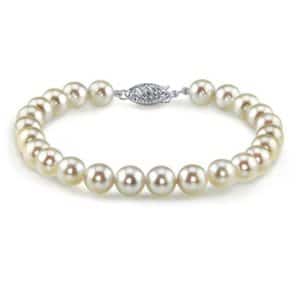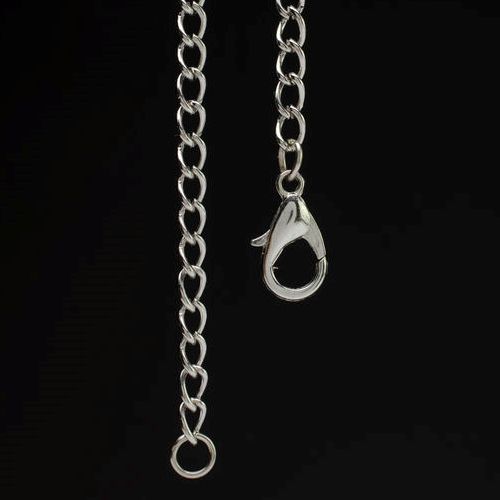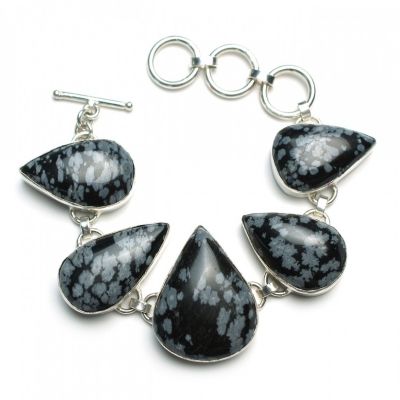

Most people don’t put much thought into the clasps on their jewelry. As long as they can open the clasp and it stays closed on its own, what more is there to know, right?
Well, there’s actually a lot! There are many different types of clasps for necklaces and bracelets.
Some are better suited to certain styles of jewelry, and some require more or less dexterity than others, so the right clasp is an important consideration when choosing a piece to wear or purchase.
We’ll tell you everything you need to know about this important piece of your jewelry!
Lobster Claw Clasp

Its shape resembles a lobster’s claw; when a tiny lever is pressed, a spring activates a hinge, pulling the bottom part of the claw toward the curved part of the clasp so a ring or loop can be hooked on. Letting go of the lever causes the clasp to close up.
Lobster claw clasps come in many sizes and styles, including a swivel style, which allows the clasp to rotate fully without twisting up the necklace or bracelet.
Lobster claws are great for jewelry of light or medium weight, but they may be difficult for people with limited dexterity.
Spring Ring Clasp

Like lobster claws, spring ring clasps are great for light- or medium-weight jewelry, but dexterity may be an issue.
Spring ring clasps are especially hard to fasten one-handed, so they may not be a good choice on a bracelet unless you know you will have someone to help you put it on.
Barrel or Screw Clasp
Barrel or screw clasps have two barrel-shaped pieces, one on either end of a necklace or bracelet. They fasten when one piece is screwed tightly inside the other.
This clasp absolutely requires two hands to fasten, so it shares the same drawbacks as a spring ring.
Slide Lock Clasp
Slide lock clasps consist of two metal tubes, one on either end of a necklace or bracelet. One tube slides inside the other and locks in place.
This clasp is specifically designed for multi-strand jewelry; each tube has little rings along it, one for each strand of the necklace or bracelet.
Slide lock clasps do not require as much dexterity as many of the other options.
Toggle Clasp

The clasp is fastened by tilting the bar to insert it through the open side and then allowing the bar to straighten out, so it catches on the ring.
There are many different styles of toggle clasps, and they are often used as decorative accents on a piece of jewelry, especially necklaces that are intended to fasten in the front.
Toggles work best with heavier jewelry since the weight of the piece will provide tension to help the necklace or bracelet stay fastened.
When choosing a piece of jewelry with a toggle clasp, be sure the bar and the open shape are good sizes so they fit together easily but are not prone to coming apart unexpectedly.
Unless the pieces of the clasp are very small, this style of clasp tends to be easier for people with limited dexterity.
S Hook Clasp
Unsurprisingly, S hook clasps have a hook, shaped like the letter S, that slides through a ring on the other end of the necklace or bracelet.
This is one of the very oldest jewelry clasps in existence, and the styles of S hooks range from simply functional to very decorative.
When choosing an S hook clasp, be sure the hook will not easily slide out of the ring and the hook will not snag on clothing or other objects.
Fish Hook Clasp
Fish hook clasps have a metal hook on one side and a delicate, oval-shaped (almost “fish-shaped”) metal box on the other.
The hook catches on a little bar inside the box and may lock with a spring mechanism.
These clasps can be quite fancy, even adorned with diamonds and other jewels, and they are usually used on classic pearl necklaces and other very elegant pieces.
Due to the delicate nature of the clasp, fishhooks can be difficult to fasten one-handed and therefore may not be a good choice for bracelets.
Magnetic Clasp
Magnetic clasps come in many shapes and sizes, and they fasten very simply, with magnets at the ends of the necklace or bracelet that snap together.
These clasps can be plain or decorative, and they are an excellent choice for people who struggle with dexterity or who always have to put on their own jewelry.
The strength of the magnets can vary from piece to piece; naturally, stronger magnets will be needed for heavier jewelry.
To Conclude
When you’re choosing a piece of fine jewelry, whether it’s for yourself or for someone else, it’s very important to notice the style of clasp it has and consider whether it will work well for the person who will wear the necklace or bracelet.
Also, when you choose a necklace or bracelet from your own collection, be sure to think about what outfit you’ll be wearing and whether you run the risk of snagging delicate fabric.
If have any questions about the clasps on your jewelry, or you’d like to learn more about how clasps can be modified, don’t hesitate to contact the experts at Copeland Jewelers!
